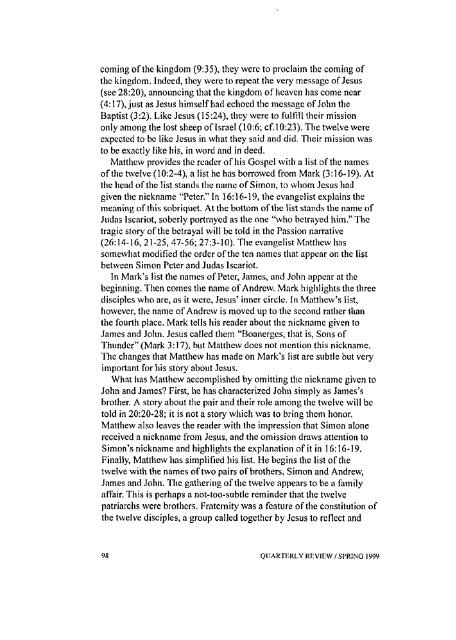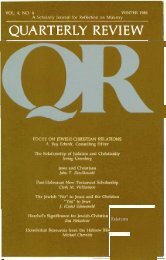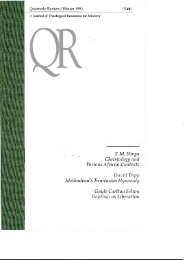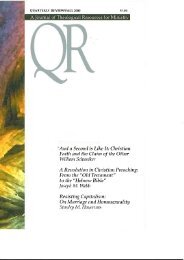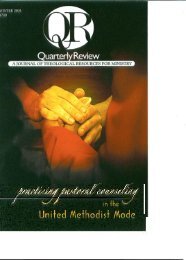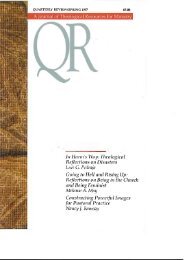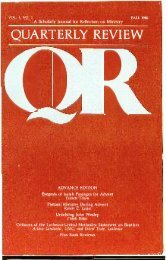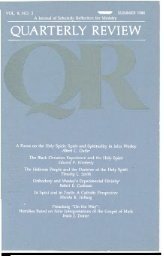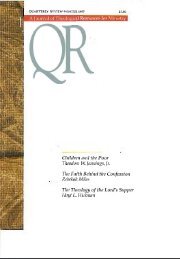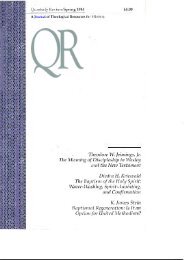Spring 1999 - Quarterly Review
Spring 1999 - Quarterly Review
Spring 1999 - Quarterly Review
Create successful ePaper yourself
Turn your PDF publications into a flip-book with our unique Google optimized e-Paper software.
coming of the kingdom (9:35), they were to proclaim the coming ofthe kingdom. Indeed, they were to repeat the very message of Jesus(see 28:20), announcing that the kingdom of heaven has come near(4:17), just as Jesus himself had echoed the message of John theBaptist (3:2). Like Jesus (15:24), they were to fulfill their missiononly among the lost sheep of Israel (10:6; cf.l0:23). The twelve wereexpected to be like Jesus in what they said and did. Their mission wasto be exactly like his, in word and in deed.Matthew provides the reader of his Gospel with a list of the namesof the twelve (10:2-4), a list he has borrowed from Mark (3:16-19). Atthe head of the list stands the name of Simon, to whom Jesus hadgiven the nickname "Peter." In 16:16-19, the evangelist explains themeaning of this sobriquet. At the bottom of the list stands the name ofJudas Iscariot, soberly portrayed as the one "who betrayed him." Thetragic story of the betrayal will be told in the Passion narrative(26:14-16, 21-25, 47-56; 27:3-10). The evangelist Matthew hassomewhat modified the order of the ten names that appear on the listbetween Simon Peter and Judas Iscariot.In Mark's list the names of Peter, James, and John appear at thebeginning. Then comes the name of Andrew. Mark highlights the threedisciples who are, as it were, Jesus' inner circle. In Matthew's list,however, the name of Andrew is moved up to the second rather thanthe fourth place. Mark tells his reader about the nickname given toJames and John. Jesus called them "Boanerges, that is, Sons ofThunder" (Mark 3:17), but Matthew does not mention this nickname.The changes that Matthew has made on Mark's list are subtle but veryimportant for his story about Jesus.What has Matthew accomplished by omitting the nickname given toJohn and James? First, he has characterized John simply as James'sbrother. A story about the pair and their role among the twelve will betold in 20:20-28; it is not a story which was to bring them honor.Matthew also leaves the reader with the impression that Simon alonereceived a nickname from Jesus, and the omission draws attention toSimon's nickname and highlights the explanation of it in 16:16-19.Finally, Matthew has simplified his list. He begins the list of thetwelve with the names of two pairs of brothers, Simon and Andrew,James and John. The gathering of the twelve appears to be a familyaffair. This is perhaps a not-too-subtle reminder that the twelvepatriarchs were brothers. Fraternity was a feature of the constitution ofthe twelve disciples, a group called together by Jesus to reflect and98 QUARTERLY REVIEW / SPRING <strong>1999</strong>


